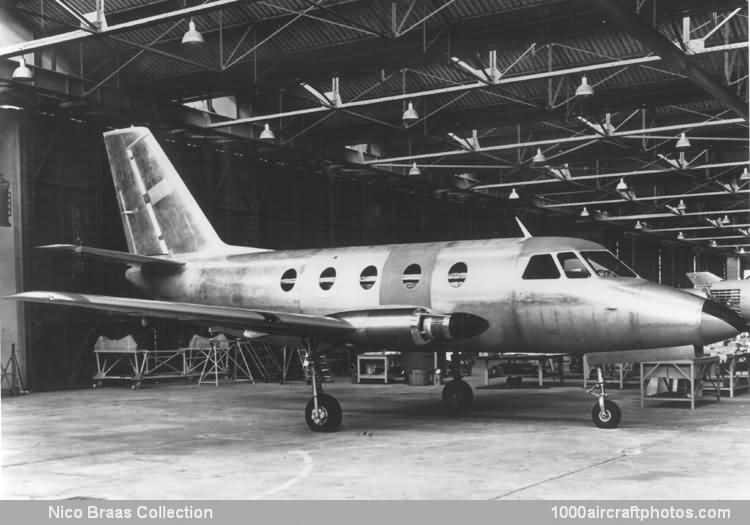04/30/2014. Remarks by Johan Visschedijk: "A model of the provisional M.D.320 design was exhibited at the 1967 Paris Air Show, and on June 28, 1967 Dassault announced its intention to proceed with development of this aircraft, to be known as the Hirondelle (Swallow). In September 1967, detail design was completed and construction of a prototype began; this aircraft made its first flight at Bordeaux-Mérignac on September 11, 1968.
Externally, the Hirondelle resembled closely the earlier M.D.415 Communauté, it was, however, an entirely new design, and had a more spacious cabin. The Hirondelle was intended primarily as a low-cost utility or executive transport, with a capacity similar to that of the more expensive turbofan-powered Mystère 20/Falcon, or as a military aircrew trainer to replace aircraft in the category of the Dassault Flamant family. It conformed to the latest FAA requirements for light transports seating 10 or more passengers.
As a feeder transport, the Hirondelle could be equipped to carry from eight to twelve passengers in a standard of comfort comparable with that of an airliner, with full pressurization and air conditioning, coat rack, baggage hold, individual reading lights, and toilets. In liaison or high-density "commuter" configuration, fourteen inward-facing seats could be installed along the sides of the cabin.
Alternatively, the Hirondelle could be fitted out as a six-passenger executive transport, with armchair seating. tables, galley and toilet; as an all-freight aircraft for up to 3,100 lb (1,400 kg) of freight; or as an ambulance, with space for three stretchers and two attendants.
However, the type was not taken into production, the details below apply to the sole prototype.
Type: Twin-turboprop executive aircraft, utility transport or trainer.
Wings: Cantilever low-wing monoplane. NACA series wing section, with increased chord on inboard sections. All-metal two-spar fail-safe structure, with some use of titanium for the engine cowlings. Split flaps and conventional ailerons. Thermal de-icing of leading edges.
Fuselage: All-metal semi-monocoque fail-safe structure. Circular cross-section.
Tail unit: Conventional fin and rudder, with sweepback. Slightly-sweptback horizontal tail surfaces, mounted on top of rear fuselage. All-metal fail-safe structure.
Landing gear: Retractable tricycle type of Messier design. Main wheels retracted inward into the wings and nose wheel forward into the fuselage. Steerable nose wheel. Main wheel legs were interchangeable, right with left. Low-pressure tires (56.9 lb/sq.in, 4.0 kg/sq.cm) for rough-field operation.
Power plant: Two 920 ehp Turboméca Astazou XIVD turboprop engines, each driving a Hamilton Standard three-blade propeller of 8 ft 0 in (2.44 m) diameter. Total fuel capacity of 642.3 gal (1,750 l).
Accommodation: Crew of one or two on flight deck, with jump-seat for a third crew member when carried. Airliner-type seating for eight, ten or twelve passengers (ten-seat layout had 32 in, 81.3 cm pitch), with galley and toilet at rear. Alternative six-seat executive or fourteen-seat high-density layouts were available. Access to passenger cabin via door on the port side, aft.
Electronics and equipment: Wide range of radio and navigation equipment, according to role, including complete ARINC system.
Systems: Cabin air conditioning, pressurization, heating and ventilation were standard."
